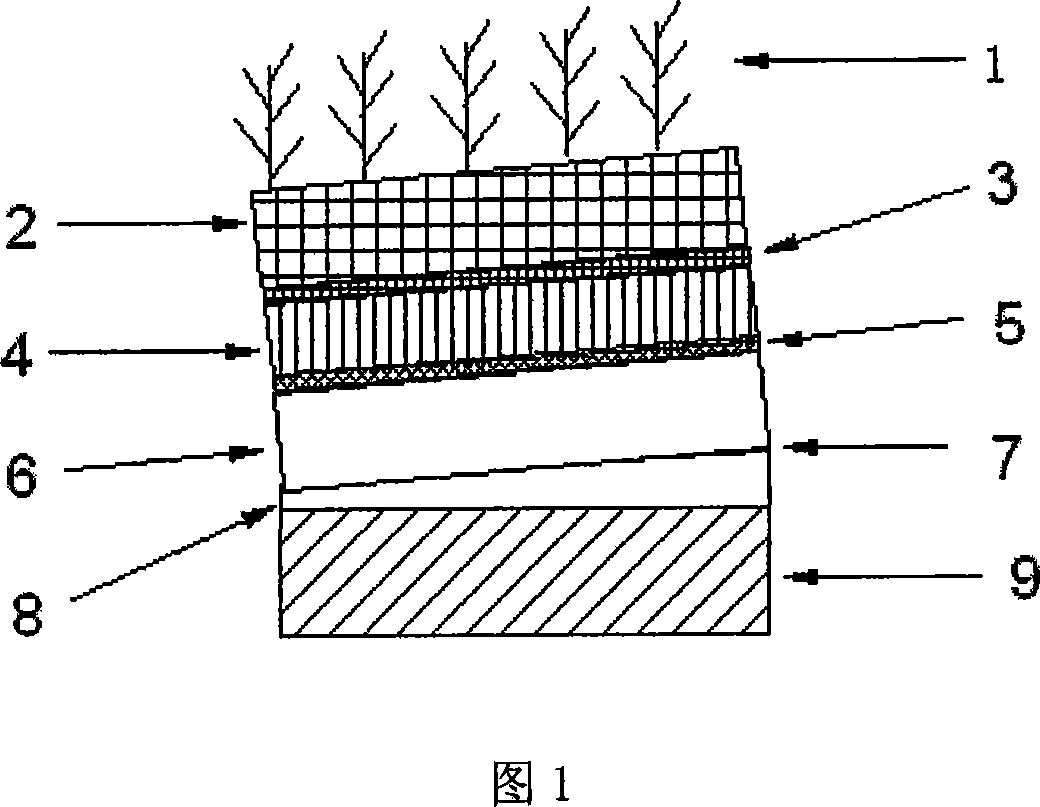Light anti-root penetration green planting roofing
A root-proof and green technology, applied in the direction of roofing, roof cladding, roof decoration, etc., can solve the problems of roof waterproofing system collapse, huge destructive power, etc.
- Summary
- Abstract
- Description
- Claims
- Application Information
AI Technical Summary
Problems solved by technology
Method used
Image
Examples
Embodiment 1
[0034] As shown in Figure 1, if the roof is a flat roof, a slope finding layer of 2% to 9% cement mortar should be made first on the base roof. The slope of the slope layer is determined according to the actual roof area. Generally, the roof ridge is used as the center line, the balcony is reversed and the slope is reversed, and the area is divided between the two water outlets in the longitudinal direction. If the roof already has a certain slope, this step is omitted. Next, some basic treatment needs to be done on the roof to achieve a smooth and clean surface. Then lay the EPS insulation board, and the insulation boards should be pressed as flush as possible, the gap between the boards should be controlled at no more than 1.5mm, and there should be no adhesive between the insulation board gaps. Lay polyvinyl chloride waterproof membrane on the insulation board to waterproof and prevent the penetration of plant roots. The direction of laying the membrane should be parallel ...
Embodiment 2
[0036] As shown in Figure 1, if the roof is a flat roof, a slope finding layer of 2% to 9% cement mortar should be made first on the base roof. The slope of the slope layer is determined according to the actual roof area. Generally, the roof ridge is used as the center line, the balcony is reversed and the slope is reversed, and the area is divided between the two water outlets in the longitudinal direction. If the roof already has a certain slope, this step is omitted. Next, some basic treatment needs to be done on the roof to achieve a smooth and clean surface. Brush the cold base oil on the slope layer, and the thickness of the cold base oil shall not be less than two coats. Then lay polyvinyl chloride waterproof membrane to waterproof and prevent the penetration of plant roots. The direction of laying the membrane should be parallel to the roof ridge, and the lap joints parallel to the roof ridge should be overlapped along the direction of the water flow. Lay 8cm thick c...
PUM
| Property | Measurement | Unit |
|---|---|---|
| Thickness | aaaaa | aaaaa |
| Plate thickness | aaaaa | aaaaa |
| Areal density | aaaaa | aaaaa |
Abstract
Description
Claims
Application Information
 Login to View More
Login to View More - R&D
- Intellectual Property
- Life Sciences
- Materials
- Tech Scout
- Unparalleled Data Quality
- Higher Quality Content
- 60% Fewer Hallucinations
Browse by: Latest US Patents, China's latest patents, Technical Efficacy Thesaurus, Application Domain, Technology Topic, Popular Technical Reports.
© 2025 PatSnap. All rights reserved.Legal|Privacy policy|Modern Slavery Act Transparency Statement|Sitemap|About US| Contact US: help@patsnap.com

